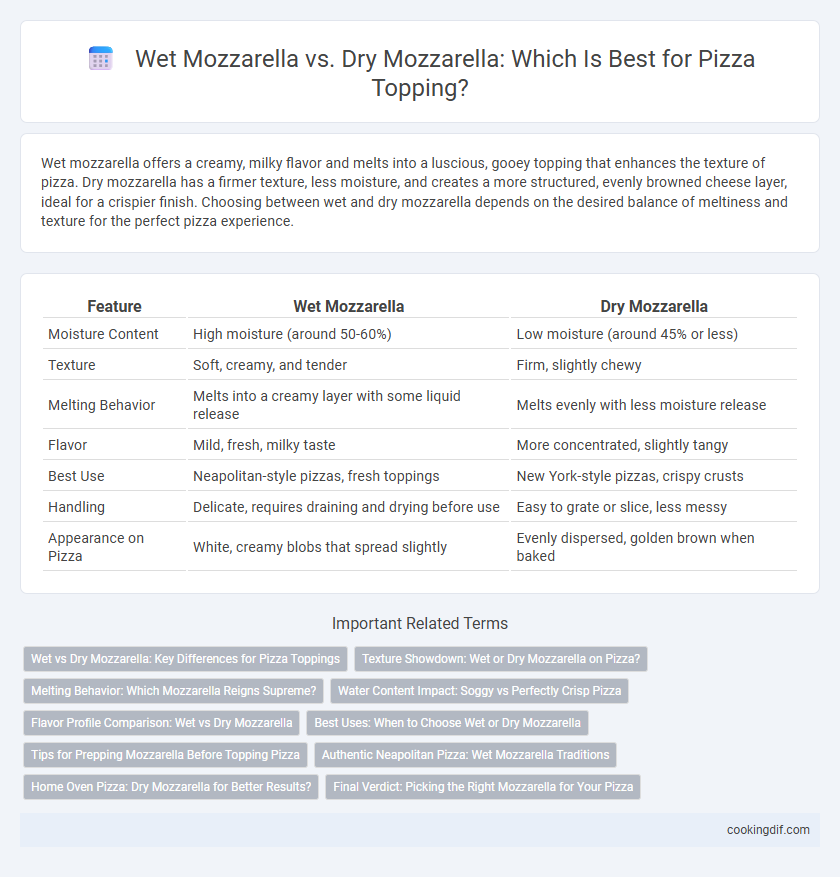Wet mozzarella offers a creamy, milky flavor and melts into a luscious, gooey topping that enhances the texture of pizza. Dry mozzarella has a firmer texture, less moisture, and creates a more structured, evenly browned cheese layer, ideal for a crispier finish. Choosing between wet and dry mozzarella depends on the desired balance of meltiness and texture for the perfect pizza experience.
Table of Comparison
| Feature | Wet Mozzarella | Dry Mozzarella |
|---|---|---|
| Moisture Content | High moisture (around 50-60%) | Low moisture (around 45% or less) |
| Texture | Soft, creamy, and tender | Firm, slightly chewy |
| Melting Behavior | Melts into a creamy layer with some liquid release | Melts evenly with less moisture release |
| Flavor | Mild, fresh, milky taste | More concentrated, slightly tangy |
| Best Use | Neapolitan-style pizzas, fresh toppings | New York-style pizzas, crispy crusts |
| Handling | Delicate, requires draining and drying before use | Easy to grate or slice, less messy |
| Appearance on Pizza | White, creamy blobs that spread slightly | Evenly dispersed, golden brown when baked |
Wet vs Dry Mozzarella: Key Differences for Pizza Toppings
Wet mozzarella contains higher moisture content, resulting in a creamy texture and a mild, milky flavor that melts smoothly on pizza but can make the crust soggy if not used carefully. Dry mozzarella, often found in blocks or shredded form, has lower moisture, providing a firmer texture and more concentrated cheesy taste that creates a crispier, less watery topping. Choosing between wet and dry mozzarella depends on the desired pizza style and texture, with wet mozzarella favored for traditional Neapolitan pies and dry mozzarella preferred for New York-style pizzas.
Texture Showdown: Wet or Dry Mozzarella on Pizza?
Wet mozzarella offers a creamy, melt-in-your-mouth texture that creates a rich, gooey topping, perfect for a classic, indulgent pizza experience. Dry mozzarella, with its firmer texture and lower moisture content, provides a slightly chewy bite and browns more evenly, ideal for achieving a crispier crust and a more structured cheese layer. Choosing between wet and dry mozzarella depends on whether you prefer a soft, luscious topping or a drier, more textured melt for your pizza.
Melting Behavior: Which Mozzarella Reigns Supreme?
Wet mozzarella contains higher moisture content, resulting in a creamy melt that creates a gooey, stretchy texture ideal for classic Neapolitan-style pizzas. Dry mozzarella, with lower moisture levels, melts less fluidly but offers a firm, slightly browned finish perfect for achieving a crispier, textural contrast on New York-style pies. Melting behavior favors wet mozzarella for a luscious, stringy topping, while dry mozzarella excels when a drier, more structured melt is desired.
Water Content Impact: Soggy vs Perfectly Crisp Pizza
Wet mozzarella contains higher water content, which can release moisture during baking, often resulting in a soggy pizza crust. Dry mozzarella, with its lower moisture level, melts evenly and helps achieve a perfectly crisp crust. Choosing dry mozzarella is essential for maintaining the ideal texture and preventing a watery, limp pizza topping.
Flavor Profile Comparison: Wet vs Dry Mozzarella
Wet mozzarella offers a creamy texture with a mild, milky flavor and higher moisture content, resulting in a softer melt and a slightly sweet taste that complements delicate toppings. Dry mozzarella provides a firmer texture with a more concentrated, tangy flavor profile, enhancing the overall depth of the pizza with a slightly saltier finish. Choosing between wet and dry mozzarella affects the pizza's moisture balance and flavor intensity, making it crucial for achieving the desired taste and texture.
Best Uses: When to Choose Wet or Dry Mozzarella
Wet mozzarella, with its high moisture content and creamy texture, is ideal for Neapolitan-style pizzas that require a rich, soft melt and a slightly watery, bubbly finish. Dry mozzarella, often aged and lower in moisture, provides a firmer texture and more intense flavor, making it perfect for New York-style or Sicilian pizzas that need a golden, stretchy cheese topping that browns well under high heat. Choosing between wet and dry mozzarella depends on the desired pizza style, melting characteristics, and moisture balance needed for the crust and overall texture.
Tips for Prepping Mozzarella Before Topping Pizza
For optimal pizza topping, wet mozzarella should be well-drained and patted dry to prevent excess moisture from making the crust soggy. Dry mozzarella, with its lower moisture content, requires less preparation but benefits from slicing or shredding to ensure even melting. Allowing either type to sit at room temperature for 15-20 minutes enhances flavor and melting consistency on the pizza.
Authentic Neapolitan Pizza: Wet Mozzarella Traditions
Authentic Neapolitan pizza uses wet mozzarella, specifically mozzarella di bufala or fior di latte, prized for its high moisture content and creamy texture that melts beautifully on the pizza. Wet mozzarella's moisture helps create the traditional soft, chewy crust with a slightly charred, flavorful finish, essential to the original Neapolitan style. Unlike dry mozzarella, which can lead to a drier, less flavorful topping, wet mozzarella ensures a rich, authentic taste and a tender, gooey melt.
Home Oven Pizza: Dry Mozzarella for Better Results?
Dry mozzarella is preferable for home oven pizza because it has lower moisture content, preventing soggy crusts and enabling even melting. This type of cheese crisps nicely and browns well under high oven temperatures typical in home kitchens. Using dry mozzarella enhances texture and flavor, delivering a more authentic pizzeria-style pizza experience.
Final Verdict: Picking the Right Mozzarella for Your Pizza
Wet mozzarella offers a creamy texture and melts smoothly, making it ideal for traditional Neapolitan-style pizzas that require a moist, tender topping. Dry mozzarella, with its lower moisture content, provides a firmer texture and less water release, perfect for crispy crusts and pizzas baked at higher temperatures. Choosing between wet and dry mozzarella depends on your desired pizza style, balancing meltability and moisture to achieve the perfect topping.
Wet mozzarella vs Dry mozzarella for topping Infographic

 cookingdif.com
cookingdif.com